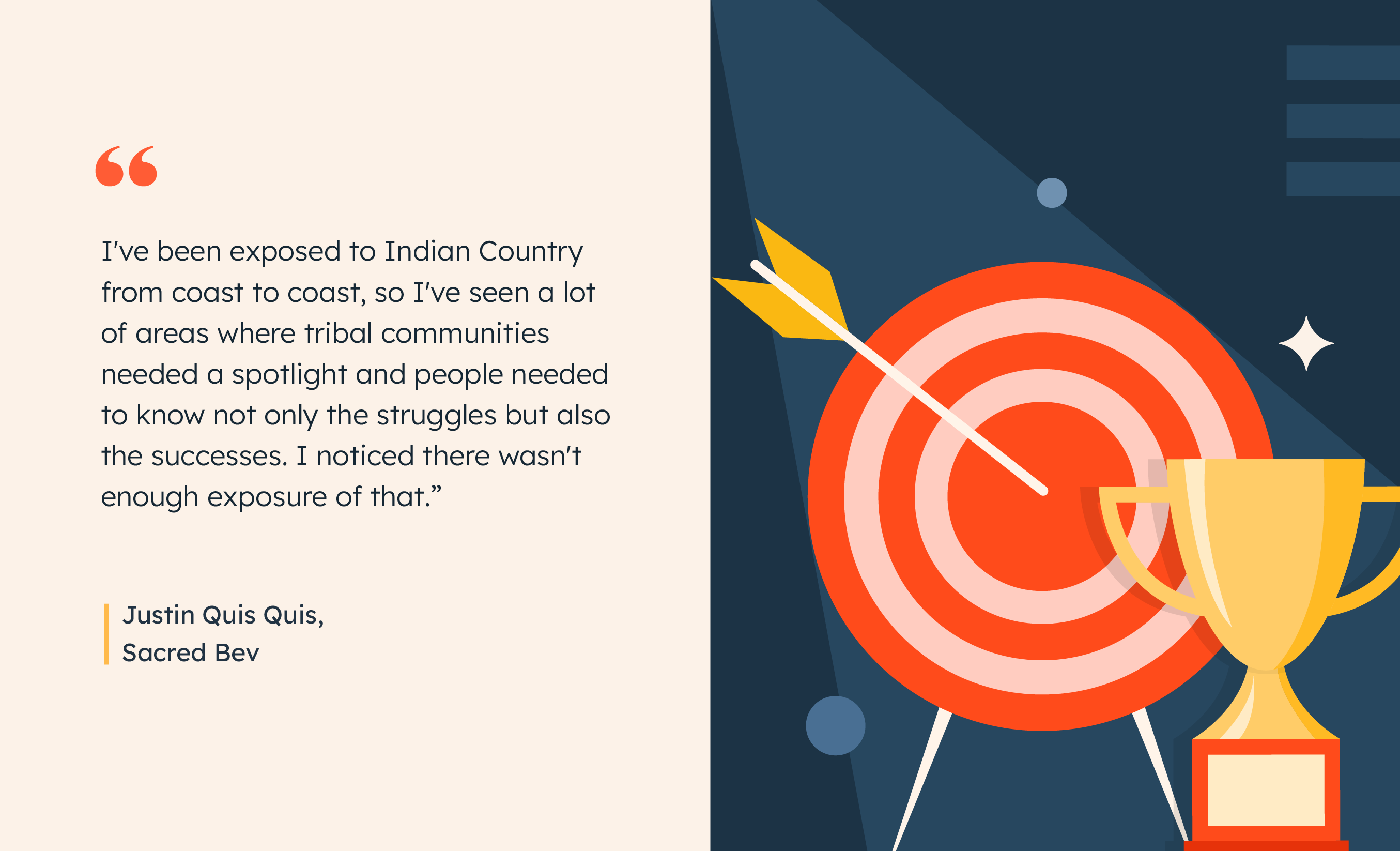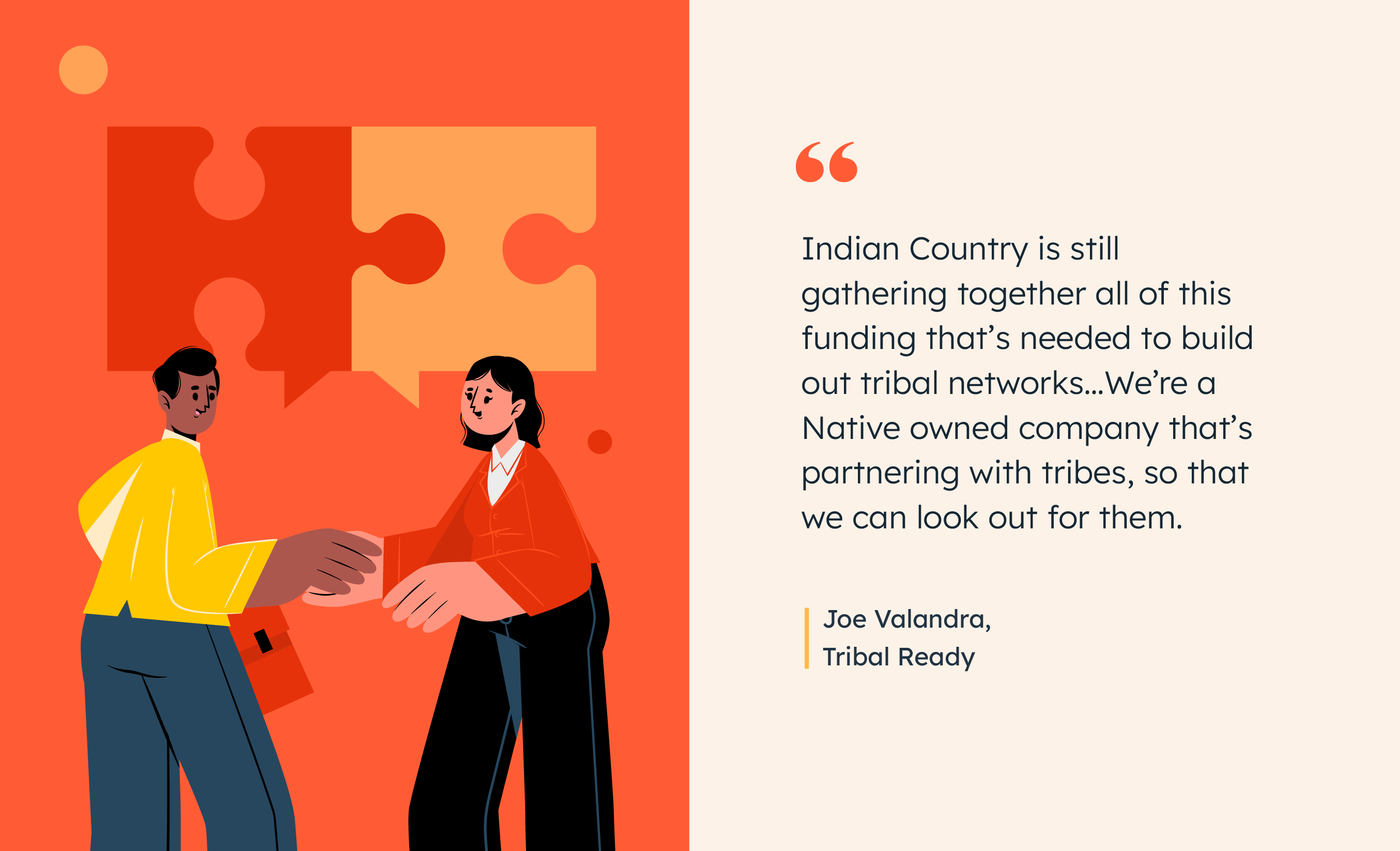Welcome to Breaking the Blueprint — a blog series that dives into the unique business challenges and opportunities of underrepresented business owners and entrepreneurs. Learn how they’ve grown or scaled their businesses, explored entrepreneurial ventures within their companies, or created side hustles, and how their stories can inspire and inform your own success.

It’s no secret that Native entrepreneurs face an uphill battle when starting up their businesses. Indigenous businesses have hurdles at nearly every step of the process, whether it’s a lack of access to credit, trouble getting technical assistance or training, or a cultural barrier between investor expectations and business owner goals.
Yet some business owners persist anyway, climbing over whatever obstacles are ahead to succeed in their respective fields.
Native entrepreneurs have moved into a multitude of industries with profitable, impactful businesses amid surges in federal and tribal support, and Indigenous people are seeing themselves represented in more swathes of the business world. In this post, I’ll introduce you to three native entrepreneurs you need to know about.
Three Native Entrepreneurs in Different Sectors
1. Amber Buker, Totem
Choctaw Nation of Oklahoma tribal member Amber Buker knew she needed a bank specifically focused on Native American needs and experiences when she discovered an “invisible gap” in traditional banking while trying to buy a house.
Buker ran into rejections from major banking institutions, primarily because none of them were aware of, or at least did not implement, the available federal support for Native American home loans. “It was a broken process where I really felt invisible,” she said. “My tribe had a down payment program, but my bank refused to help me use it.”

That represented Buker’s wider experience with banks, even as she began working in the industry through a friend’s business. Realities for Native Americans meant that even basic security policies, such as refusing to mail debit cards to PO boxes, inhibited people’s ability to use traditional banks and, by extension, access the wider economy (not everyone on a reservation has a personal mailbox – meaning some Natives wouldn’t be able to get a debit card at all).
Because of that, Native Americans have become per-capita the most unbanked demographic in the United States, Buker said, with 16 percent completely disconnected from the banking system, per a report by Bankrate.com.
However, under Buker’s guidance, financial technology and banking company Totem plans to change that.
By building a bank that understands the lived experiences of Native users, Totem will boost Natives’ engagement with a system that has often failed them. To date, the company has introduced spend accounts that are not only accessible online but also designed to withstand connectivity fluctuations and weak signals, which often pose challenges for rural Native tribal members residing in remote reservation lands.
“We wanted to have a safe, free account that benefits could be deposited into, and we also prioritize features that uphold Native values,” Buker said. “Sending money from Totem account to Totem account is free and instant. For example, there’s a lot of times where auntie needs 20 bucks, so being able to share funds is super important.”
Totem also provides information and resources on what kinds of support exist for Native homebuyers, healthcare users, and even utility assistance – and that’s just the start. For their next step, Totem wants to help tribal governments deliver benefits and payments directly to citizens, foregoing the current intermediaries like paper checks and pre-paid cards. Through Totem, more tribal members will get to keep more of their benefit dollars.
“A prepaid card doesn’t give you regulation protections, or has FDIC insurance, or an easily obtained replacement. All these things are what make banks so valuable in the first place,” Buker said. “We want to tackle the root of the problem, which is access to good, safe banking products.”
2. Justin Quis Quis, Sacred Bev
Justin Quis Quis spent a long time as a member of leadership for the San Manuel Band of Mission Indians near San Bernadino, California. When his time helping to lead his tribe came to a close, he knew he wanted to keep going and push into new frontiers.
In this instance, it was functional beverages – think energy drinks or herbal teas. Quis Quis looked out at an exploding functional beverage market and saw room for a Native presence. He identified where he could leverage Native traditional thinking into a product while calling attention to the fact that Indigenous people were still a part of modern life.
“I‘ve been exposed to Indian Country from coast to coast, so I’ve seen a lot of areas where tribal communities needed a spotlight, and people needed to know not only the struggles but also the successes,” Quis Quis said. “I noticed there wasn’t enough exposure to that.”

Quis Quis secured some financial investors and partners and started up Sacred Bev, headquartered in San Diego. The company’s first three flavors —Immunity, Wellness, and Tranquility —launched earlier this year and have proven popular, growing from an initial run of 7,200 cans to a second run of 17,200 cans. The drinks sell everywhere, from convenience and grocery stores to tribal casinos, Quis Quis said, and the company doesn’t plan to slow down any time soon.
The positive reception has encouraged Quis Quis to take the next steps towards scaling up, working with a cannery in Los Angeles to begin growing his operation while expanding out with a distributor.
“We’re stoked,” he stated. “We really felt like we had a good thing on our hands, and we’ve gotten some very positive reviews. We‘ve secured 14 individual accounts, some tribal, some off-reservation, and we’ve secured a distributor that’s sent hundreds of cases to mini-marts and grocery stores. We were authenticated through the IAC. The drinks have been very popular.”
The drinks have been popular enough to warrant considering who ends up leading Sacred Bev down the line, and Quis Quis has ideas on that, too. Many of Quis Quis’ partners and investors are other tribes or associates from his time in San Manuel leadership. Moreover, he has begun reaching out to other tribes in hopes of sourcing as many ingredients for the drinks – which utilize natural flavors like prickly pears, blackberries, and pomegranates – from Native sources as possible.
The goal is to make sure Sacred Bev, if acquired, remains under Native leadership, Quis Quis said.
“A big part of our deal is that no matter what happens with this company down the road that we want it to be tribally owned and operated at the end of the day,” he affirmed. “I want to be able to get some of these herbs and others from Native communities for sure. I haven‘t been able to find somebody through my sources, but I’m hoping someone will come to us with a big prickly pear farm or tons of ginger and peppermint. I‘m sure there is, but I haven’t been able to find that. That would be the best for us.”
3. Joe Valandra, Tribal Ready
Rosebud Sioux Tribe member Joe Valandra sees a lot of opportunities in Indian Country amid a historic surge in support for tribal broadband. Through federal opportunities like the Broadband Equity, Access, and Deployment program or the Tribal Broadband Connectivity Program (both under the National Telecommunications and Information Administration,) tribes have found themselves managing gargantuan new projects with potentially colossal impacts on their communities.
In the wake of those opportunities, consultancies and contractors have sprung up to help send dollars where they need to go. Valandra wants to leverage his history in Indian Country as a contractor, gaming operator, and, well, as a Native American to make sure tribes are getting the best work they can for their money.
To that end, Valandra formed the consultancy Tribal Ready in January 2023. The first six months of the company’s existence have been “a whirlwind,” he shared. Tribal Ready has partnered with technology platform Ready.net to help tribes figure out everything from which kind of networks best suit their needs to negotiating feasibility and environmental impact studies ahead of build-outs.
“Indian Country is still gathering together all of this funding that’s needed to build out tribal networks. We’re helping tribes do feasibility studies or write grants, and then we’re going to help write requests for proposals and make sure deliverables line up with the RFPs we helped write,” Valandra said. “We have kind of an evolving business model. We’re a Native-owned company that’s partnering with tribes, so that we can look out for them.”

It’s no surprise Valandra’s services are in demand, given a renewed national interest in tribal connectivity in the wake of COVID-19. Longstanding challenges facing tribal members in rural locations worsened when telehealth, distance learning, and remote work became the norm. The situation garnered an unprecedented amount of support from the federal government – support that now needs to end up in the right hands to make the biggest difference, Valandra said.
Sometimes, that means helping tribes set up a new provider service on their reservation and take that over. Sometimes, it means managing the provider for the tribe in question or buying a nearby provider to expand its existing services into a new area focusing on supporting Native citizens, Valandra said.
However the final arrangements look, tribes should have as much control of their connectivity infrastructure and service as possible, he added.
“Over the last 50 years, the federal government has provided an awful lot of funding to improve rural connectivity, but very little of that was actually seen in Indian Country,” Valandra said. “For tribes to control the infrastructure that supports and delivers broadband service to their members is absolutely vital, without question.”
- SEO Powered Content & PR Distribution. Get Amplified Today.
- PlatoData.Network Vertical Generative Ai. Empower Yourself. Access Here.
- PlatoAiStream. Web3 Intelligence. Knowledge Amplified. Access Here.
- PlatoESG. Carbon, CleanTech, Energy, Environment, Solar, Waste Management. Access Here.
- PlatoHealth. Biotech and Clinical Trials Intelligence. Access Here.
- Source: https://blog.hubspot.com/marketing/native-entrepreneurs-different-sectors





